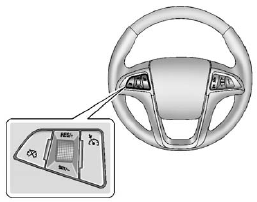Cruise Control
With cruise control, the vehicle can maintain a speed of about 40 km/h (25 mph) or more without keeping your foot on the accelerator. Cruise control does not work at speeds below 40 km/h (25 mph).
On vehicles with the Traction Control System (TCS) or the StabiliTrak® system, it may begin to limit wheel spin while you are using cruise control. If this happens, the cruise control will automatically disengage. See Traction Control System (TCS) or StabiliTrak® System.
WARNING!
Cruise control can be dangerous
where you cannot drive safely at
a steady speed. So, do not use
the cruise control on winding
roads or in heavy traffic.
Cruise control can be dangerous
on slippery roads. On such roads,
fast changes in tire traction can
cause excessive wheel slip, and
you could lose control. Do not use
cruise control on slippery roads.

The cruise control buttons are located on the steering wheel.
 (On/Off): Press to turn the
cruise control system on and off. An
indicator light will turn on or off in
the instrument panel cluster.
(On/Off): Press to turn the
cruise control system on and off. An
indicator light will turn on or off in
the instrument panel cluster.
 (Cancel): Press to disengage
cruise control without erasing the
set speed from memory.
(Cancel): Press to disengage
cruise control without erasing the
set speed from memory.
RES/+ (Resume/Accelerate):
Move the thumbwheel up to make the vehicle resume to a previously set speed or to accelerate.
SET/− (Set/Coast): Move the thumbwheel down to set the speed and activate cruise control or make the vehicle decelerate.
See also:
Exterior
Described by Buick as having a "refined ruggedness," the Rendezvous has an
overall shape like that of an SUV, augmented by details that promote a youthful
image. Sharp lines take precede ...
Questions and Answers About
Safety Belts
Q: Will I be trapped in the vehicle after a crash if I
am wearing a safety belt?
A: You could be — whether you are wearing a safety
belt or not. But your chance of being conscious
during and ...
Vehicle Information Menu Items
Press MENU on the turn signal
lever until Vehicle Information Menu
is displayed. Use to scroll
through the following menu items:
• Unit
• Tire Pressure
• Jump Start (eAssist Only)
• ...


